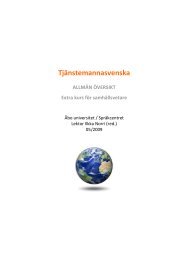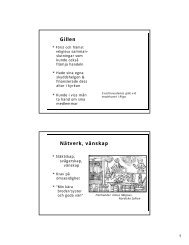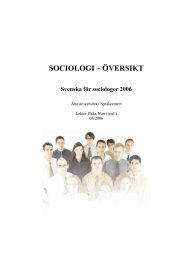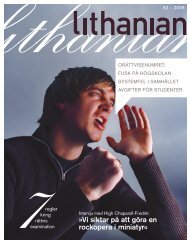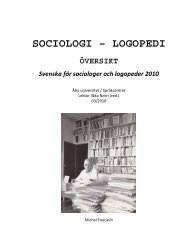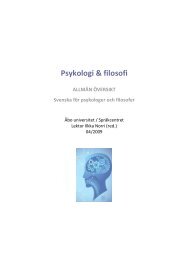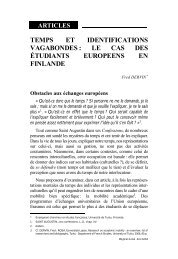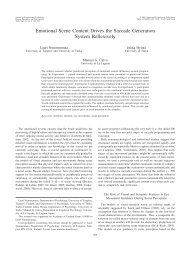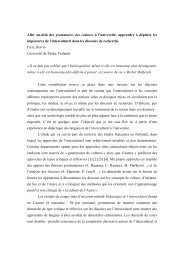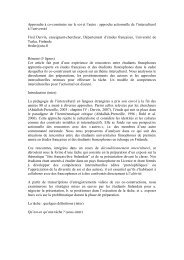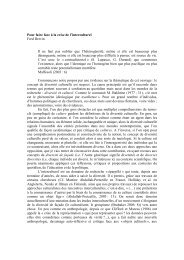treecreeper Certhia familiaris - Käyttäjien kotisivut - Users' home ...
treecreeper Certhia familiaris - Käyttäjien kotisivut - Users' home ...
treecreeper Certhia familiaris - Käyttäjien kotisivut - Users' home ...
You also want an ePaper? Increase the reach of your titles
YUMPU automatically turns print PDFs into web optimized ePapers that Google loves.
J. Avian Biol. 38: 619624, 2007<br />
doi: 10.1111/j.2007.0908-8857.03926.x<br />
# 2007 The Authors. J. Compilation # 2007 J. Avian Biol.<br />
Received 15 February 2006, accepted 2 October 2006<br />
Within territory abundance of red wood ants Formica rufa is<br />
associated with the body condition of nestlings in the Eurasian<br />
<strong>treecreeper</strong> <strong>Certhia</strong> <strong>familiaris</strong><br />
Ari Jäntti, Petri Suorsa, Harri Hakkarainen, Jouni Sorvari, Esa Huhta and Markku Kuitunen<br />
A. Jäntti and M. Kuitunen (correspondence), Dept. of Biological and Environmental Science, University of Jyväskylä, P.O. Box 35,<br />
FIN-40351 Jyväskylä, Finland. E-mail: markku.kuitunen@jyu.fi. P. Suorsa, H. Hakkarainen and J. Sorvari, Section of Ecology,<br />
Dept. of Biology, University of Turku, FIN-20014 Turku, Finland. E. Huhta, Finnish Forest Research Institute, Kolari Research<br />
Station, Muoniontie 21A, FIN-95900 Kolari, Finland.<br />
Studies on individual reproductive success in relation to interspecific competition between distantly related taxa<br />
are scarce. We studied whether the abundance of red wood ants Formica rufa -group is related to the breeding<br />
habitat selection, fecundity and offspring quality in the Eurasian <strong>treecreeper</strong> <strong>Certhia</strong> <strong>familiaris</strong>, an old-growth<br />
forest passerine. The nest-box occupancy data were gathered over a five-year study period, whereas the breeding<br />
performance analyses were based on a two-year data set. The abundance of wood ants, measured within 50 m<br />
around the nest-boxes, was not related to nest-box occupancy rate, fecundity or the physiological stress of<br />
nestlings. In contrast, the abundance of wood ants was negatively related to the offspring quality and life-history<br />
traits, such as lowered body mass, subcutaneous fat reserves, and tarsus length at fledging. Our results suggest<br />
that exploitative competition between distantly related taxa may have considerable and adverse influences on<br />
nestling quality as measured by body mass, subcutaneous, fat and tarsus length. Red wood ants may decrease the<br />
fitness of <strong>treecreeper</strong>s as the lower body condition of nestlings has the potential to impair recruitment into the<br />
breeding population and, additionally, impair the future reproductive effort.<br />
The most intensive examples of interspecific competition<br />
in natural populations are principally documented<br />
between closely related species with similar niches<br />
(Connell 1983; Schoener 1983, Punttila et al. 1994,<br />
Confer et al. 2003). Recently, however, competition has<br />
been recognized between very dissimilar taxa (Haemig<br />
1996, 1999, Aho et al. 1997). Aho et al. (1997)<br />
demonstrated that the Eurasian <strong>treecreeper</strong> <strong>Certhia</strong><br />
<strong>familiaris</strong>, which belongs to the bark-foraging guild,<br />
can be affected by resource competition with red wood<br />
ants, the Formica rufa -group.<br />
Competition between species can be defined in two<br />
major ways; (1) exploitative competition and (2) interference,<br />
i.e., contest competition (Amarasekare 2002,<br />
Hawes et al. 2002). Exploitative competition, also called<br />
scramble or resource competition, involves indirect<br />
negative interactions arising from the use of a common<br />
resource by different consumer species (Haemig 1992,<br />
1994). Conversely, interference competition involves<br />
direct negative interactions arising from territoriality,<br />
overgrowth, undercutting, predation or chemical competition<br />
in which one species can negatively alter the<br />
foraging behaviour of other species (Haemig 1996).<br />
Exploitative competition between <strong>treecreeper</strong>s and<br />
red wood ants for the same food sources has been<br />
suggested to have negative effects on the breeding<br />
performance of <strong>treecreeper</strong>s (Aho et al. 1997, Aho et al.<br />
1999). In general, the lack of food may lead to chronic<br />
physiological stress in nestlings (Nunez-de la Mora et al.<br />
1996, Suorsa et al. 2003).<br />
One crucial component of body mass in birds is the<br />
subcutaneous fat reserve. These reserves can change<br />
dynamically over a 24 hour period (Cresswell 1998)<br />
and they represent the most important source of stored<br />
energy in passerines (Blem 1990). An increase in fat<br />
reserves during cold weather reduces the risk of<br />
619
starvation during cold nights and winter storms (e.g.<br />
Lahti et al. 1998). In contrast, extremely high fat<br />
reserves may reduce manoeuvrability or increase exposure<br />
time to predators (Lima 1986, Witter et al.<br />
1994).<br />
Eurasian <strong>treecreeper</strong> breeds throughout the northern<br />
coniferous zone (Kuitunen 1987). Breeding <strong>home</strong> range<br />
size is approximately 10 hectares; a rather large territory<br />
for a small passerine (Kuitunen and Törmälä 1983).<br />
The first broods are reared in April and May when<br />
snow cover and night frosts are still common. About<br />
one third of the females laid a second clutch in June or<br />
July (Aho et al. 1999). The forest dwelling <strong>treecreeper</strong><br />
specializes in catching bark-dwelling invertebrates on<br />
tree trunks; it does not eat ants. Treecreepers prefer<br />
larger tree trunks to forage on (Suhonen and Kuitunen<br />
1991).<br />
In Finland the Formica rufa -group includes the ant<br />
species F. aquilonia, F. lugubris, F. polyctena, F. pratensis<br />
and F. rufa (Collingwood 1979). Of red wood ants,<br />
F. aquilonia and F. polyctena are the two dominant<br />
species in our study area. They are polygynous (multiple<br />
queens in a single nest), polydomous (multiple nest<br />
coexist in the same area without competition) and exist<br />
in large mature forests (Punttila et al. 1994, Punttila<br />
1996). Their dry weighted diet consists of sugars from<br />
aphids’ honeydew (82%), arthropods (18%) and seeds<br />
(2%) (Rosengren and Sundström 1991). The <strong>treecreeper</strong>s<br />
and wood ants use similar food sources and thus<br />
have the combined potential to significantly reduce the<br />
biomass of bark-dwelling invertebrates (Haemig 1994,<br />
Jäntti et al. 2001).<br />
In this study we explored the relationship between the<br />
abundance of red wood ants and several life-history traits<br />
of <strong>treecreeper</strong>s deepening the results of Aho et al. (1997)<br />
by providing nest-boxes in forest patches characterized<br />
by low to high red wood ant densities. We assessed<br />
whether the red wood ant levels are related to:(1) nestbox<br />
occupancy rate, (2) fecundity, (3) individual body<br />
condition, and (4) individually measured physiological<br />
stress in <strong>treecreeper</strong> chicks.<br />
Methods<br />
The study was conducted around the Konnevesi<br />
Research Station and in the rural region of Laukaa in<br />
Central Finland (62837?N, 26820?E) during the summers<br />
of 19992003. The study area is mainly<br />
coniferous forest dominated by Norway spruce Picea<br />
abies and Scots pine Pinus sylvestris, though two birch<br />
species Betula pendula and B. pubescens, and other<br />
hardwood species are present. The remaining area<br />
consists of open habitats such as cultivated fields,<br />
clear-cuts, roads, lakes and mires. We placed two<br />
nest-boxes 30 m apart in the interior of 228 separate<br />
forest patches having a mean age of 52 years (Suorsa<br />
et al. 2003). Each forest patch contained two nest-boxes<br />
for the first and second breeding attempts respectively<br />
(Kuitunen 1987).<br />
Nest-boxes were checked daily to determine the<br />
occupancy rate, clutch size, numbers of nestlings, and<br />
the nestling mortality rate. Nest-boxes were considered<br />
occupied if they contained some nest material and adults<br />
were observed within the territory. Morphological<br />
measurements of nestlings were collected prior to<br />
fledging (ca 14 days of age). Wing length was measured<br />
to the nearest 1 mm by the maximum method (Svensson<br />
1992) and body mass was measured to the nearest 0.1 g<br />
with Pesola spring balance. Subcutaneous fat in the<br />
abdomen and tracheal pit as well as the condition of the<br />
pectoral muscle, were recorded on a 03 scale (Gosler<br />
1991). Physiological stress was measured already in<br />
9 day-old nestlings with an Amersham radioimmunoassay<br />
of plasma corticosterone (RIA) kits (Biotrak rat<br />
corticosterone [ 125 I], Amersham, UK) in the summer of<br />
2000 (see details in Suorsa et al. 2003).<br />
Of the 228 nest-box pairs, we measured red wood<br />
ant abundance around 146. We located all the nest<br />
mounds within a radius of 50 m from the <strong>treecreeper</strong>s<br />
nest, and measured their basal diameter to the nearest<br />
0.01 m. The total basal area of the nest mounds (Sm 2<br />
varying from 0 to 12.41, mean 1.9592.74 SD,<br />
n146) were used as an estimate of the red wood<br />
ant abundance around the nest-boxes (modified after<br />
Klimetzek 1981, Deslippe and Savolainen 1994). The<br />
basal area of nest mound has been shown to correlate<br />
well with the number of worker ants in Formica -species<br />
(Breen 1979, Deslippe and Savolainen 1994, Liautard<br />
et al. 2003).<br />
First, we studied the association between the<br />
abundance of red wood ants and the nest-box occupancy<br />
rate using a five-year breeding data set from 1999<br />
to 2003. We ran a generalized linear model (SAS,<br />
GENMOD procedure) which allowed for the analysis<br />
of the binomial error variance. In this analysis, a nestbox<br />
pair was used as the sampling unit (n146) and<br />
the proportion of occupied nests over the five year study<br />
(number of occupied breeding seasons/total number of<br />
potential breeding seasons) was used as a dependent<br />
variable (binomial error term, logit link-function). The<br />
abundance of wood ants, as measured by the total area<br />
of the nest mounds within a radius of 50 m from the<br />
nest, was used as an independent quantitative variable<br />
in the analysis.<br />
Second, we analyzed the effects of ants on clutch size<br />
and fledgling production using breeding attempt (both<br />
first and second clutches from 1999 to 2000) as a<br />
sampling unit. The years from 2001 to 2003 were not<br />
included since other experimental work done during<br />
these years might have affected breeding performances.<br />
We also omitted the nests destroyed by nest predators,<br />
620
to focus explicitly on the effects of wood ants. We used<br />
a four-way mixed-model ANOVA design with each<br />
breeding attempt as a sampling unit (n183). Year<br />
(1999 vs 2000) and brood (first vs second) were<br />
regarded as fixed factors, while territory was treated as<br />
a random factor. The continuous abundance of wood<br />
ants acted as an independent quantitative variable in the<br />
analysis. The presented results were obtained after the<br />
deletion of non-significant interaction terms.<br />
The same factorial design was used in five separate<br />
four-way mixed-model ANOVAs to explore the effects<br />
of wood ants on nestling quality using body mass, fat<br />
and muscle indices, and wing and tarsus lengths as<br />
dependent variables. In these analyses, individual nestlings<br />
were treated as sampling units (n598) and the<br />
data covered the years of 19992000.<br />
Finally, we conducted a three-way mixed model<br />
ANOVA to study the effects of wood ants on individually<br />
measured plasma corticosterone levels. These data<br />
were collected in the summer of 2000 and included 243<br />
nestlings. Year was treated as a fixed factor, territory as a<br />
random factor and the abundance of wood ants as an<br />
independent quantitative variable. The generalized<br />
linear model analysis was carried out in SAS 8.2 with<br />
procedure GENMOD, and all the other analyses were<br />
conducted in SPSS 10.2.<br />
Results<br />
The abundance of red wood ants (within a radius of<br />
50 m from the nest-box) was not associated with the<br />
occupancy rate of nest-boxes over the five-year study<br />
period (generalized linear model, x 2 0.74, df1, P<br />
0.39). Similarly, neither the clutch size nor the numbers<br />
of fledged chicks were related to the abundance of wood<br />
ants during 19992000 (Table 1). In contrast, the high<br />
wood ant levels were adversely associated with measurements<br />
of individual quality such as body mass, subcutaneous<br />
fat content, and tarsus length at fledging<br />
(Table 2; Fig. 1). The condition of the pectoral muscle<br />
seemed to be related to the abundance of wood ants<br />
differently during 1999 and 2000 (see significant<br />
Table 1. Results of the mixed-models ANOVAs on the effects of<br />
year, brood and abundance of wood ants on the clutch size and<br />
the number of fledglings using territory as a random factor.<br />
Clutch size<br />
Number of fledglings<br />
Year F 1,59 1.67 P0.20 F 1,58 2.68 P0.11<br />
Brood F 2,59 2.21 P0.12 F 2,58 1.35 P0.27<br />
Wood ants F 1,59 0.25 P0.62 F 1,59 0.00 P0.96<br />
Year P0.05<br />
P0.05<br />
wood ants<br />
Brood<br />
wood ants<br />
P0.05<br />
P0.05<br />
Table 2. Results of the mixed-model ANOVAs on the effects of wood ants on the quality of the 14-d-old <strong>treecreeper</strong> nestlings using territory as a random factor. The results are shown<br />
from the models were insignificant interaction terms were removed. Abbreviation (-) depicts the direction of the effect.<br />
Yearwood ants Yearbrood<br />
Year (1999, 2000) Brood (first, second) Wood ants (radius of 50 m)<br />
(Sarea of nest mounds m 2 )<br />
Body mass (g) F1,292.7 3.037 P0.082 F1,406.5 65.020 P0.001 (-) F1,62.1 6.503 P0.013 P0.05 ns<br />
Fat index (04) F1,401.5 79.527 PB0.001 F1,493.0 41.156 PB0.001 (-) F1,73,4 6.283 P0.014 P0.05 ns<br />
Muscle index (04) F1,447.9 2.553 P0.111 F1,532.2 0.261 P0.610 F1,79.9 1.048 P0.309 F1,386.8 5.349 P0.05<br />
Wing length (mm) F 1,418.3 20.595 PB0.001 F 1,507.8 4.762 P0.030 F 1,76.3 2.646 P0.108 P0.05 P0.05<br />
Tarsus length (mm) F 1,235.4 0.622 P0.431 F 1,348.7 69.328 PB0.001 (-) F 1,66.8 6.496 P0.013 P0.05 P0.05<br />
621
Predicted tarsus length (mm)<br />
Predicted fat index<br />
Predicted body mass (g)<br />
10.0<br />
9.5<br />
9.0<br />
8.5<br />
8.0<br />
7.5<br />
7.0<br />
3.5<br />
3.0<br />
2.5<br />
2.0<br />
1.5<br />
1.0<br />
0.5<br />
0.0<br />
16.2<br />
16.0<br />
15.8<br />
15.6<br />
15.4<br />
15.2<br />
15.0<br />
0<br />
0<br />
(a)<br />
2 4 6 8 10 12 14<br />
Amount of wood ants (m 2 )<br />
(b)<br />
2 4 6 8 10 12 14<br />
Amount of wood ants (m 2 )<br />
(c)<br />
interaction term in Table 2). Yet, when the years were<br />
analysed separately, muscle condition showed no significant<br />
effect from wood ants (mixed-model ANOVA<br />
P0.18 for all of the comparisons). Additionally, the<br />
wing length (Table 2) and corticosterone levels were not<br />
related to wood ant abundance (mixed-model ANOVA:<br />
factor brood F 2,31.4 34.10, P0.001; covariate wood<br />
ants F 1,18.3 0.16, P0.69; using territory as a random<br />
factor).<br />
Discussion<br />
We found evidence that the quality of <strong>treecreeper</strong><br />
nestlings was adversely associated with the abundance of<br />
red wood ants dwelling in the territories. Body mass,<br />
subcutaneous fat index and tarsus length of nestlings<br />
were all lower when the abundance of red wood ants in<br />
territories was high. This result supports the suggestion<br />
that <strong>treecreeper</strong>s may be affected by exploitative<br />
resource competition with red wood ants (Aho et al.<br />
1999). Haemig (1996) compared the effects of interference<br />
competition on the foraging behaviour of<br />
distantly-related taxa, specially Formica aquilonia and<br />
great tits. It was found that tree trunks without ants<br />
were visited by great tits more frequently and for longer<br />
time periods than those tree trunks containing ants.<br />
Furthermore, the biomass of arthropod prey for birds<br />
may be greater in trees from which wood ants have been<br />
excluded (Skinner and Whittaker 1981, Haemig 1994).<br />
The level of arthropod biomass on trees also increases<br />
with distance from the ant nest mound (Laine and<br />
Niemelä 1980, Aho et al. 1999, Jäntti et al. 2001).<br />
Body mass is partly a measure of the body size and<br />
partly a measure of condition, and it seems to be more<br />
sensitive than tarsus length to environmental variation<br />
(Keller and van Noorwijk 1991). In nestlings, the<br />
development of body mass, tarsus length, and fat reserves<br />
are known to be good predictors of future survival. In<br />
addition to body mass, the tarsus length has been shown<br />
to be a good indicator of future success in chicks. In the<br />
coal tit Parus ater, relative tarsus length was significantly<br />
associated with juvenile recruitment and both relative<br />
tarsus length and body condition were positively<br />
associated with the probability of individuals becoming<br />
residents within their native area during the next winter<br />
(Brotons and Broggi 2003). This indirectly shows that<br />
skeletal size may affect the social status of juveniles<br />
during winter, which may further influence survival<br />
probabilities.<br />
14.8<br />
0 2 4 6 8 10 12 14<br />
Amount of wood ants (m 2 )<br />
Fig. 1 (Continued)<br />
Fig. 1. Predictions of body mass (a), fat index (b) and tarsus<br />
length (c) in relation to the abundance of wood ants within<br />
<strong>treecreeper</strong> territories in 1999 (filled circles) and 2000 (open<br />
circles). Predicted values are based on models presented in the<br />
Table 2.<br />
622
Suorsa et al. (2003) found that the concentration of<br />
plasma corticosterone in nestlings of <strong>treecreeper</strong>s was<br />
higher in a dense, young forest habitat with a poor food<br />
supply than in a sparse, old forest with better food<br />
resources. In addition, the nestlings in large forest<br />
patches had lower corticosterone levels and better body<br />
condition than those in small forest patches. In this<br />
study, we did not find any association between the<br />
abundance of red wood ants in territories and corticosterone<br />
levels in nestlings. This suggests that the effect of<br />
breeding habitat quality on <strong>treecreeper</strong> corticosterone<br />
levels may be stronger than that of the red wood ants.<br />
When <strong>treecreeper</strong>s choose their territories in winter or<br />
early spring, they cannot estimate the abundance of red<br />
wood ants directly because of deep snow cover. This<br />
may also explain that the occupancy rate of nest-boxes<br />
was not related to the abundance of red wood ants.<br />
However, earliest possible egg laying is one of the most<br />
important determinants of reproductive success in birds<br />
(e.g. Svensson 1997, Visser and Verboven 1999). In the<br />
<strong>treecreeper</strong>, early breeding could be one way to avoid<br />
competition with wood ants since ants are not active in<br />
the cold weather during early spring.<br />
We conclude that exploitative competition between<br />
distantly related taxa can have considerable and adverse<br />
influences on nestling quality as measured by body<br />
mass, subcutaneous fat and tarsus length. The lower<br />
body condition of nestlings has the potential to impair<br />
recruitment into the breeding population and additionally<br />
impair the future reproductive effort.<br />
Acknowledgements We are grateful for the field works done<br />
by Heikki Helle, Anna-Riikka Ihantola, Sanna Kataja and<br />
Mirka Hankkila. We also thank Gerald Niemi, Nick<br />
McCann, and others at the round table discussion group of<br />
University of Minnesota, NRRI for their valuable comments<br />
on the manuscript. The Konnevesi Research Station and rural<br />
area of Laukaa provided an excellent environment for the field<br />
work. We thank Jyrki Raatikainen who made the nest boxes.<br />
The <strong>treecreeper</strong>s were captured and blood sampled with the<br />
permission of the Environmental Centre of Central Finland.<br />
We also thank the Academy of Finland for financial support<br />
to A. Jäntti, H. Hakkarainen, and M. Kuitunen and the<br />
University of Jyväskylä for financial support to A. Jäntti.<br />
References<br />
Aho, T., Kuitunen, M., Suhonen, J., Jäntti and Hakkari, T.<br />
1997. Behavioural responses of Eurasian <strong>treecreeper</strong>,<br />
<strong>Certhia</strong> <strong>familiaris</strong>, to competition with ants. Anim.<br />
Behav. 54: 12831290.<br />
Aho, T., Kuitunen, M., Suhonen, J., Jäntti, A. and Hakkari,<br />
T. 1999. Reproductive success of Eurasian <strong>treecreeper</strong>,<br />
<strong>Certhia</strong> <strong>familiaris</strong>, is lower in territories with wood ants.<br />
Ecology 80: 9981007.<br />
Amarasekare, P. 2002. Interference competition and species<br />
coexistence. Proc. R. Soc. B 269: 25412550.<br />
Blem, C. R. 1990. Avian energy storage. Curr. Ornithol. 7:<br />
59113.<br />
Breen, J. 1979. Worker populations of Formica lugubris<br />
ZETT. Nests in Irish plantation woods. Ecol. Entomol.<br />
4: 17.<br />
Brotons, L. and Broggi, J. 2003. Influence of morphology on<br />
winter residence and recruitment in juvenile coal tits<br />
(Parus ater) after the post-fledging period. Ecoscience<br />
10: 273282.<br />
Collingwood, C. A. 1979. The Formicidae (Hymenoptera) of<br />
Fennoscandia and Denmark. Fauna Entomol. Scand. 8:<br />
1174.<br />
Confer, J. L., Larkin, J. L. and Allen, P. E. 2003. Effects of<br />
vegetation, interspecific competition, and brood parasitism<br />
on golden winged warbler (Vermivora chrysoptera)<br />
nesting success. Auk 120: 138144.<br />
Connell, J. H. 1983. On the prevalence and relative<br />
importance of interspecific competition: evidence from<br />
field experiments. Am. Nat. 122: 661696.<br />
Cresswell, W. 1998. Diurnal and seasonal mass variation<br />
in blackbirds, Turdus merula: consequences for massdependent<br />
predation risk. J. Anim. Ecol. 67: 7890.<br />
Deslippe, R. J. and Savolainen, R. 1994. Role of food supply<br />
in structuring a population of Formica ants. J. of Anim.<br />
Ecol. 63: 756764.<br />
Gosler, A. G. 1991. On the use of greater covert molt and<br />
pectoral muscle as measures of condition in passerines<br />
with data for the great tits Parus major. Bird Study 38:<br />
19.<br />
Haemig, P. D. 1992. Competition between ants and birds in<br />
a Swedish forest. Oikos 65: 479483.<br />
Haemig, P. D. 1994. Effects of ants on the foraging of birds<br />
in spruce trees. Oecologia 97: 3540.<br />
Haemig, P. D. 1996. Interference from ants alters foraging<br />
ecology of great tits. Behav. Ecol. Sociobiol. 38: 2529.<br />
Haemig, P. D. 1999. Predation risk alters interactions among<br />
species: competition and facilitation between ants and<br />
nesting birds in a boreal forest. Ecol. Lett. 2: 178184.<br />
Hawes, C., Stewart, A. J. A. and Evans, H. F. 2002. The<br />
impact of wood ants (Formica rufa) on the distribution<br />
and abundance of ground beetles (Coleoptera: Carabidae)<br />
in a Scots pine plantation. Oecologia 131: 612619.<br />
Jäntti, A., Aho, T., Hakkarainen, H., Kuitunen, K. and<br />
Suhonen, J. 2001. Prey depletion by the foraging of the<br />
Eurasian <strong>treecreeper</strong>, <strong>Certhia</strong> <strong>familiaris</strong>, on tree-trunk<br />
arthropods. Oecologia 128: 488491.<br />
Keller, L. F. and van Noorwijk, A. J. 1991. A method<br />
to isolate environmental effects on nestling growth,<br />
illustrated with examples from the great tit (Parus major).<br />
Funct. Ecol. 7: 493502.<br />
Klimetzek, D. 1981. Population studies of hill-building wood<br />
ants of the Formica rufa-group. Oecologia 48: 418<br />
421.<br />
Kuitunen, M. 1987. Seasonal and geographical variation in<br />
the clutch size of the common <strong>treecreeper</strong> (<strong>Certhia</strong><br />
<strong>familiaris</strong>). Ornis Fenn. 64: 125136.<br />
Kuitunen, M. and Törmälä, T. 1983. The food of <strong>treecreeper</strong><br />
<strong>Certhia</strong> f. <strong>familiaris</strong> nestlings in southern Finland.<br />
Ornis Fenn. 60: 4244.<br />
623
Lahti, K., Orell, M., Rytkönen, S. and Koivula, K. 1998.<br />
Time and food dependence in willow tit winter survival.<br />
Ecology 79: 29042916.<br />
Laine, K. J. and Niemelä, P. 1980. The influence of ants on<br />
survival of mountain birches during an Oporinia autumnata<br />
(Lepidoptera, Geometridae) outbreak. Oecologia<br />
47: 3942.<br />
Liautard, C., Brown, W. D., Helms, K. R. and Keller, L.<br />
2003. Temporal and spatial variations of gyne production<br />
in the ant Formica exsecta. Oecologia 136: 558564.<br />
Lima, S. L. 1986. Predation risk and unpredictable feeding<br />
conditions: determinants of body mass in birds.<br />
Ecology 67: 377385.<br />
Nunez-de la Mora, A., Drummond, H. and Wingfield, J. C.<br />
1996. Hormonal correlates of dominance and starvation-induced<br />
aggression in chicks of the blue-footed<br />
boody. Ethology 102: 748761.<br />
Punttila, P. 1996. Succession, forest fragmentation, and the<br />
distribution of wood ants. Oikos 75: 291298.<br />
Punttila, P., Haila, Y., Niemelä, J. and Pajunen, T. 1994. Ant<br />
communities in fragments of old-growth taiga and<br />
managed surroundings. Ann. Zool. Fenn. 31: 131<br />
144.<br />
Rosengren, R. and Sundström, L. 1991. The interaction<br />
between red wood ants, Cinara aphids and pines. A ghost<br />
of mutualism past? In: Huxley, C. R. and Cutler, D. F.<br />
(eds). Ant-plant interactions. Oxford University, pp.<br />
8091.<br />
Schoener, T. W. 1983. Field experiments on interspecific<br />
competition. Am. Nat. 122: 240285.<br />
Skinner, G. J. and Whittaker, J. B. 1981. An experimental<br />
investigation of inter-relationships between the wood-ant<br />
(Formica rufa) and some tree-canopy herbivores. J. of<br />
Anim. Ecol. 50: 313326.<br />
Suhonen, J. and Kuitunen, M. 1991. Intersexual foraging<br />
niche differentiation within the breeding pair in the<br />
common <strong>treecreeper</strong>-Ornis Scand. 66: 5361.<br />
Suorsa, P., Huhta, E., Nikula, A., Nikinmaa, M., Jäntti, A.,<br />
Helle, H. and Hakkarainen, H. 2003. Forest management<br />
is associated with physiological stress in an old-growth<br />
forest passerine. Proc. R. Soc. B 270: 963969.<br />
Svensson, L. 1992. Identification guide to European passerines.<br />
Fingraf AB.<br />
Svensson, E. 1997. Natural selection on avian breeding time:<br />
causality, fecundity-dependent, and fecundity-indepent<br />
selection. Evolution 51: 12761283.<br />
Visser, M. E. and Verboven, N. 1999. Long-term fitness<br />
effects of fledging date in great tits. Oikos 85: 445<br />
450.<br />
Witter, M. S., Cuthill, I. C. and Bonser, R. H. C. 1994.<br />
Experimental investigation of mass-dependent predation<br />
risk in the European starling, Sturnus vulgaris. Anim.<br />
Behav. 48: 210222.<br />
624




